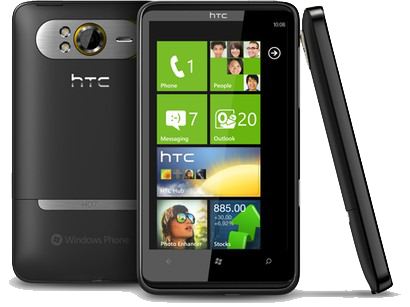HTC HD7 Windows Phone 7 Smartphone: Review

A useful and well-executed device, but will it fly off the shelves?
In the months leading up to Windows Phone 7’s launch, any number of pundits seemed more than happy to opine that the chances of survival for the platform, once released, were equivalent to that of a turtle trying to cross six lanes of busy highway: Absolute zero.
Whether Windows Phone 7 can endure for the longer-term remains to be seen, but the hardware and software hitting the market in the platform’s first iteration has more than enough to recommend it. eWEEK Europe gave the LG E900 a thumbs-up , and that opinion is reinforced by the HTC HD7.
Windows Phone 7 forsakes the iPhone’s and Android’s grid-like pages of individual apps for a series of subject-specific “Hubs,” meant to consolidate both applications and Web content into an intuitive and easy-to-access format. For example, the “People” Hub draws contact data from a number of online sources: with a few taps, you can see an individual’s phone number, a link to their personal site, and an option to write on their Facebook wall. In similar fashion, the “Music + Videos” Hub offers access not only to Zune media, but also online radio such as Slacker.
Hardware and Calling
 As a phone, the HTC HD7 is a solidly built device with a 4.3-inch touch screen (480 x 800 WVGA) and a 1-GHz processor – Microsoft is keeping a tight leash on its manufacturers by imposing minimum hardware requirements. The metal edges are nicely curved, and the back panel offers enough friction to prevent the smartphone from sliding off a table or out of your hand.
As a phone, the HTC HD7 is a solidly built device with a 4.3-inch touch screen (480 x 800 WVGA) and a 1-GHz processor – Microsoft is keeping a tight leash on its manufacturers by imposing minimum hardware requirements. The metal edges are nicely curved, and the back panel offers enough friction to prevent the smartphone from sliding off a table or out of your hand.
Tipping the scales at 5.7 ounces, the HD7 feels comfortable in one’s grip; at one point, I spent 40 minutes with the handset pressed to my ear, without wishing I had used an earpiece instead. Sound quality for calls was crystal clear, and T-Mobile managed to not drop a single call over the five days of testing. The touch screen itself was pleasingly responsive, operating at what you might call the Goldilocks equilibrium: not needing too hard a press, nor activating at too light a brush, but seemingly just right for navigation.
[We found no evidence of the antenna problem reported in the HTC HD7 – Editor]
Camera
The phone also comes with a 5-megapixel color camera with auto-focus and dual LED flash, which can also record 720p HD video. The camera itself is capable of adequate but unspectacular images, both indoors and out, and the software offers a variety of options for those shutterbugs who like to tinker with effects, resolution, flicker adjustment and the like. Its Achilles’ heel is the mechanical shutter button on the right-hand side of the device’s exterior rim, which requires such a hard and decisive push that it frequently jostles your frame out of position—a software-based shutter button, like the one found on Android smartphones, would have suited much better. On the upside, you can easily upload your photos to the cloud.
Kickstand
The HD7’s back includes a kickstand integrated into the camera aperture, which clicks out to rest the smartphone in landscape mode. Such kickstands are becoming standard-issue for more media-centric mobile devices like this one, which comes with a preinstalled Netflix app. Quality-wise, video seemed a little muddier than on some rival devices, such as the iPhone 4 (with its Retina Display) and the Samsung Galaxy S (with its Super AMOLED screen – reviewed here). As with most smartphones with plus-size screens, the HD7 also has a bit of a battery-life issue: more than once I found myself turning off the phone by midday to conserve power, after a fairly intensive few hours of Web cruising, e-mail answering and video-watching. For most users, though, a full charge may very well see them from dawn to dusk.
Continued on page 2…